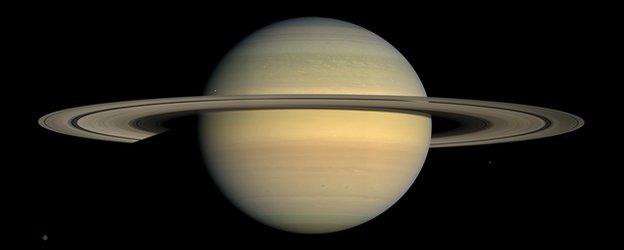Probe to end mission in ring gap
- Published

Cassini will carry out a series of "proximal orbits" between Saturn and its innermost ring
The Cassini space probe will dive into the narrow gap between Saturn's atmosphere and its innermost ring for the final leg of its mission in 2016.
Cassini has been orbiting Saturn from a distance - outside the ring system.
The last set of orbits will bring the spacecraft up close, offering new scientific insights, perhaps even clues to the age of its majestic rings.
They offer the final chance to gather data before Cassini is destroyed in Saturn's atmosphere.
The mission's project scientist Linda Spilker at the 43rd Lunar and Planetary Science Conference (LPSC) in the Woodlands, Texas.
"In 2016, there's a really neat end to the mission. What we'll do is take the spacecraft from orbiting outside the rings and dive into and orbit through the very narrow gap between the upper atmosphere and the innermost ring," Dr Spilker, from Nasa's Jet Propulsion Laboratory (JPL), told “óĻó“«Ć½ News.
This set of 22 "proximal orbits" will allow mission scientists to map the gravity field and magnetic field of Saturn in detail, hopefully shedding light on a discrepancy in the planet's internal rotation rate.
These orbits will be highly inclined - meaning the orbit is tipped by tens of degrees away from horizontal around the equator. They should allow the spacecraft to gather high-resolution data on Saturn's ring system, allowing scientists to more accurately measure their mass.
This could shed light on their age; for example, whether the rings are relatively recent and formed by the break up of a comet, or whether they date to the beginning of the Solar System more than four billion years ago.
"I think this will be a great phase of the mission," Dr Spilker told the LPSC meeting. The final stage of the mission will carry out similar science to that planned for the Juno mission which is on its way to explore another gas giant - Jupiter.
In 2017, once Cassini's fuel has all but run out, ground controllers will command the spacecraft to plunge into the planet's atmosphere, where it will be destroyed.
As the spacecraft hurtles towards Saturn, it will become incredibly hot, but will not burn up because of the lack of oxygen in the atmosphere. Instead, it will melt and ultimately be crushed by huge pressures.
Scientists are keen to avoid any chance that parts of Cassini will end up on Saturn's moons Enceladus or Titan (targets of interest in the search for extraterrestrial life) and contaminate them with any Earth bugs that have survived all these years on the spacecraft.
In the 1990s, the Galileo spacecraft was destroyed in a similar way in the atmosphere of Jupiter.
By the time Cassini ends, it will leave behind an outstanding legacy. In eight years at Saturn, the mission has made spectacular discoveries about the ringed planet and its moons - and there may be more to come.
It has discovered giant plumes of liquid water coming from an ocean beneath the moon Enceladus, observed weather systems on Titan and studied the "shepherd moons" that keep Saturn's rings in check.
Paul.Rincon-INTERNET@bbc.co.uk and follow me on
- Published6 March 2012
- Published21 April 2011
- Published31 March 2011
- Published6 October 2010